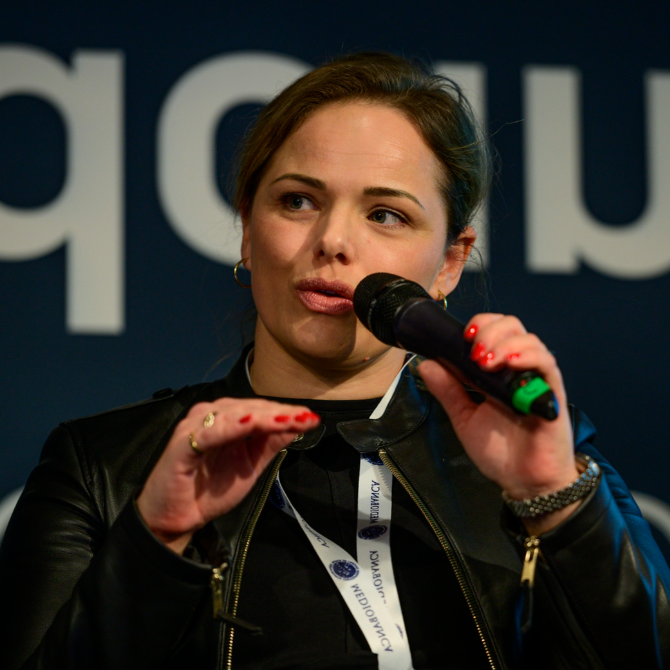A group of five panellists including fintech companies and banks discussed the transformation brought to the market by technology and automation at the SRP Europe Conference 2024 in London on 20 March.
Artificial intelligence (AI) has undoubtedly become a buzzword in the fintech world as the buy-side mulls over how technology can help structure existing portfolios and generate dashboards to grow and manage their structured products activity.
The more customised something is, the more need you will have for a human being to be part of this value chain - Susan Niederhöfer, LPA
However, “AI is not everything”, noted Susan Niederhöfer (pictured), global head of sales at Frankfurt-based LPA Group.
“In order to increase the level of awareness of the buy-side to use platforms and additional sales channels, [the focus should be on] marketing these instruments and those platforms correctly,” she said, noting the importance of automation in streamlining internal processes.
There’s been a significant change “from incremental to exponential”, specifically from automation of paper-based processes to scalability and growth.
According to Niederhöfer, it’s not difficult to offer bespoke products, or “complex products”, via platforms, but there are still issues around the lack of consideration for the entire value chain among issuers and manufacturers.
“The more customised something is, the more need you will have for a human being to be part of this value chain,” she said.
Nowadays structured product is a “technology-enabled” business, which covers pricing, execution, product creation, distribution to life cycle management, said David Wood, managing director at Luma Financial Technologies.
“One of the unintended consequences of regulation is that it actually forced the industry to go through a much more systematic process in terms of how it runs the [structured products] business”, said Wood.
Headquartered in Cincinnati, the buy-side focused fintech provider which now has a global footprint delivers customisable solution to discover, research, purchase and manage structured products.
Regional differences
Wood highlighted common elements across markets - Asia, Europe, Middle East, Latin America, Africa besides US - despite behavioural differences.
“Automated pricing has been very common in Europe and Asia for quite some time. But it was nearly impossible to get an auto price on a multi-issuer platform in the US three years ago,” he recalled.
For the US market where Luma currently houses around 20 issuers that provide automated pricing, it is very heavily focused on building and adding distribution process around products, which includes education down to the adviser level.
“We're seeing that flow back down into the European market now,” said Wood, adding that a key focus for both markets is an increased attention to the whole life cycle of products as end customers expect a higher level of service than in the past.
Wood noted that there is “a real change” in Luma's home market, which is not necessarily at the same level as in Switzerland where investors can get bespoke products for as less as CHF10,000.
“But the US will get there one day,” he said.
Gurpreet Kharaud, global head of equities digital markets at J.P. Morgan, echoed on the regional differences when it comes to usage of structured products platforms.
With the Asian market being the poster child, the US investment banking giant has replicated the model to leverage the same core technology investments in Europe and the US.
One-stop-shop
According to Kharaud, a key factor of automation in Asia is the level of “low touch in zero times”, meaning that sales and trading have had “de minimis involvement” in Asia where almost 99% of the bank’s structured product trades are transacted via its SI 360 platform whereas the proportion comes to approximately 90% and 60% in Europe and US, respectively.
“Our goal is to have an omni channel approach. It depends upon the market, the client and the appetite,” said Kharaud.
Subject to trade volume, J.P. Morgan offers a range of options including multi-issuer platform, application programming interface (API) and email pricer.
Portfolio management and lifecycle management are key to investors from a technology standpoint while issuers' ability to provide markets for secondary also makes a difference and gives an edge, said Elias Milan (above), global head of exotic products e-business at Société Générale corporate and investment banking.
According to Milan, investor education remains a critical factor to achieve scalability. “Accessibility and suitability of the products and their regulatory path is helping us in this matter,” he said.
At ERIYA, a Swiss financial services start-up the aim is to bring one-stop access to structured products and asset-backed securities via an investment factory platform and multi-asset trading services to the buy-side, including asset managers, family offices, independent asset managers, banks and pension funds.
Sandro Schmidlin (below, right), managing partner & founder at ERIYA noted that platforms can also help to closely interact with the buy-side from idea generation before the execution.
“Technology for structure products is not only just about the optimisation of the fitted structure, [but also] to define and evaluate the underlying [exposure],” he said. “Therefore, we have an order system for clients, which is an equity selection tool based on fundamental and quantitative research.”
The Swiss firm currently works with 16 companies on the sell-side offering around 20 technology solutions including email processor and optimisation tools.
“What we see from our clients is a demand for a combination of technology and personal advice,” said Schmidlin.
Do you have a confidential story, tip or comment you’d like to share? Write to Summer.Wang@derivia.com



